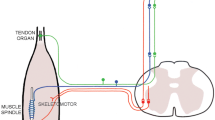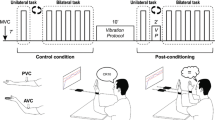Abstract
The present-day view of the neural basis for the senses of muscle force and heaviness is that they are generated centrally, within the brain, from copies of motor commands. A corollary of the motor discharge generates a sense of effort which underlies these sensations. In recent experiments on force and heaviness sensations using thumb flexor muscles, a rather different explanation has been invoked: Subjects were proposed to rely predominantly on inputs of a peripheral origin, in particular, the signals of muscle spindles. The present experiments have been carried out at the elbow joint to determine whether these new ideas apply more widely. The effects of fatigue of elbow flexor muscles have been studied in force and heaviness matching tasks using three exercise regimes, a sustained maximum voluntary contraction (MVC), a maintained contraction of 35 % MVC, and a maintained contraction of 35 % MVC combined with muscle vibration at 80 Hz. In force-matching experiments, subjects were required to contract both arms and while the reference arm generated the target force under visual control, it was matched by the indicator arm without visual feedback. During the 100 % MVC exercise, force in the exercising reference arm fell rapidly to almost a half of its original value over 90 s while force in the indicator did not fall, leading to a significant overestimation of the reference force. During the 35 % MVC exercise, subjects also overestimated the reference force and this persisted at 5 and 10 min after the exercise. When 35 % MVC was combined with vibration, the amount by which the indicator arm overestimated the reference force was significantly reduced. In heaviness matching experiments, subjects could move their arms through a small range. The reference arm was loaded with a weight, and weights were added or removed from the indicator until heaviness felt the same in the two arms. There was a small, but significant fall in the matching weight used after 100 % MVC exercise, that is, the weight held by the fatigued arm felt lighter. The 35 % exercise did not alter heaviness sensation while 35 % MVC exercise with vibration led to a significant reduction in perceived heaviness. To conclude, while the results of these experiments on elbow flexors are not as clear cut as for thumb flexors, the central effort hypothesis falls short, in a number of respects in explaining the data which are able to be interpreted in terms of a peripheral afferent contribution to the senses of force and heaviness.







Similar content being viewed by others
References
Allen TJ, Leung M, Proske U (2010) The effect of fatigue from exercise on human limb position sense. J Physiol 588(8):1369–1377. doi:10.1113/jphysiol.2010.187732
Brown MC, Engberg I, Matthews PB (1967) The relative sensitivity to vibration of muscle receptors of the cat. J Physiol 192(3):773–800
Carson RG, Riek S, Shahbazpour N (2002) Central and peripheral mediation of human force sensation following eccentric or concentric contractions. J Physiol 539:913–925
Clark FJ, Burgess RC, Chapin JW, Lipscomb WT (1985) Role of intramuscular receptors in the awareness of limb position. J Neurophysiol 54(6):1529–1540
Ernst MO, Banks MS (2002) Humans integrate visual and haptic information in a statistically optimal fashion. Nature 415:429–433
Fallon JB, Macefield VG (2007) Vibration sensitivity of human muscle spindles and golgi tendon organs. Muscle Nerve 36(1):21–29. doi:10.1002/mus.20796
Gandevia SC, Smith JL, Crawford M, Proske U, Taylor JL (2006) Motor commands contribute to human position sense. J Physiol 571(3):703–710. doi:10.1113/jphysiol.2005.103093
Goodwin GM, McCloskey DI, Matthews PBC (1972) The contribution of muscle afferents to kinaesthesia shown by vibration induced illusions of movement and by the effects of paralysing joint afferents. Brain 95:705–748
Gregory JE, Proske U (1979) The responses of golgi tendon organs to stimulation of different combinations of motor units. J Physiol 295:251–262
Gregory JE, Morgan DL, Proske U (1988) Responses of cat muscle spindles and errors of limb position sense in man. J Neurophysiol 59(4):1220–1230
Izumizaki M, Tsuge M, Akai L, Proske U, Homma I (2010) The illusion of changed position and movement from vibrating one arm is altered by vision or movement of the other arm. J Physiol 588:2789–2800
Jones LA, Hunter IW (1983) Effect of fatigue on force sensation. Exp Neurol 81(3):640–650
Luu BL, Day BL, Cole JD, Fitzpatrick RC (2011) The fusimotor and reafferent origin of the sense of force and weight. J Physiol 589(13):3135–3147. doi:10.1113/jphysiol.2011.208447
Macefield G, Hagbarth K-E, Gorman R, Gandevia SC, Burke D (1991) Decline in spindle support to α-motoneurones during sustained voluntary contractions. J Physiol 440:497–512
McCloskey DI (1981) Corollary discharges: motor commands and perception. In: Brookhart J, Mountcastle V, Brooks V, Geiger S (eds) Handbook of physiology, section 1, the nervous system, vol II, motor control. American Physiological Society, Bethesda, MD, pp 1415–1447
McCloskey DI, Ebeling P, Goodwin GM (1974) Estimation of weights and tensions and apparent involvement of a “sense of effort”. Exptl Neurol 42:220–232
Merton PA (1964) Human position sense and sense of effort. Sym Soc Exp Biol 18:387–400
Morgan DL, Prochazka A, Proske U (1984) The after-effects of stretch and fusimotor stimulation on the responses of primary endings of cat muscle spindles. J Physiol 356:465–477
Morgan DL, Proske U, Gregory JE (1991) Responses of primary endings of cat muscle spindles to locally applied vibration. Exp Brain Res 87:530–536
Proske U (2006) Kinesthesia: the role of muscle receptors. Muscle Nerve 34(5):545–558. doi:10.1002/mus.20627
Proske U, Gandevia SC (2012) The proprioceptive senses: their roles in signaling body shape, body position and movement, and muscle force. Physiol Rev 92(4):1651–1697. doi:10.1152/physrev.00048.2011
Proske U, Morgan DL, Gregory JE (1993) Thixotropy in skeletal muscle and in muscle spindles: a review. Prog Neurobiol 41(6):705–721. doi:10.1016/0301-0082(93)90032-n
Roll JP, Vedel JP, Ribot E (1989) Alteration of proprioceptice messages induced by tendon vibration in man: a microneurographic study. Exp Brain Res 76(1):213–222
Seizova-Cajic T, Smith JL, Taylor JL, Gandevia SC (2007) Proprioceptive movement illusions due to prolonged stimulation: Reversals and aftereffects. PLoS ONE 2(10). doi:10.1371/journal.pone.0001037
Simon AM, Ferris DP (2008) Lower limb force production and bilateral force asymmetries are based on sense of effort. Exp Brain Res 187:129–138
Simon AM, Kelly BM, Ferris DP (2009) Sense of effort determines lower limb force production during dynamic movement in individuals with poststroke hemiparesis. Neurorehabil Neural Repair 23:811–818
Thompson S, Gregory JE, Proske U (1990) Errors in force estimation can be explained by tendon organ desensitisation. Exp Brain Res 79:365–372
Vallbo AB (1971) Muscle spindle response at the onset of isometric voluntary contractions in man. Time difference between fusimotor and skeletomotor effects. J Physiol 218(2):405–431
Vallbo AB (1974) Human muscle spindle discharge during isometric voluntary contractions. Amplitude relations between spindle frequency and torque. Acta Physiol Scand 90(2):319–336
van Beers RJ, Sittig AC, Denier van der Gon JJ (1999) Integration of proprioceptive and visual position information: an experimentally supported model. J Neurophysiol 81:1355–1364
Weerakkody N, Percival P, Morgan DL, Gregory JE, Proske U (2003) Matching different levels of isometric torque in elbow flexor muscles after eccentric exercise. Exp Brain Res 149(2):141–150
Yamamoto T, Morgan DL, Gregory JE, Proske U (1994) Blockade of intrafusal neuromuscular junctions of cat muscle spindles with gallamine. Exp Physiol 79(3):365–376
Acknowledgments
We would like to thank Dr. R. C. Fitzpatrick for his comments on the manuscript.
Author information
Authors and Affiliations
Corresponding author
Rights and permissions
About this article
Cite this article
Brooks, J., Allen, T.J. & Proske, U. The senses of force and heaviness at the human elbow joint. Exp Brain Res 226, 617–629 (2013). https://doi.org/10.1007/s00221-013-3476-6
Received:
Accepted:
Published:
Issue Date:
DOI: https://doi.org/10.1007/s00221-013-3476-6




